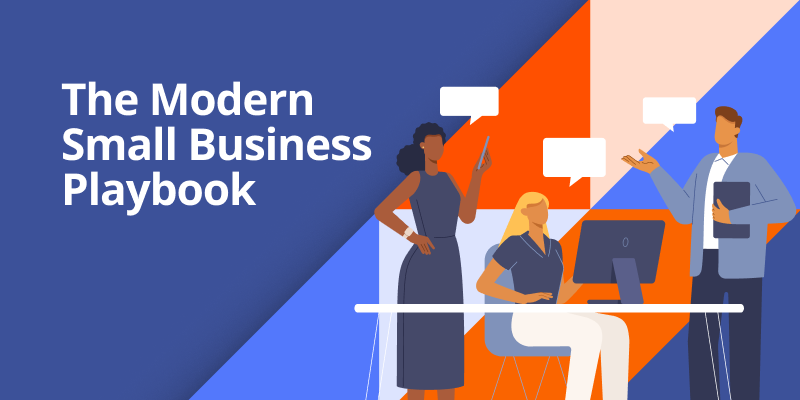Providing your customers an experience worth talking about is your ace in the hole. But what exactly is customer experience (CX)?
Customer Experience is how your customers perceive your business based on every interaction, start to finish.
Right now, you might be thinking, isn’t that just customer service? No, it’s not. Customer service and customer experience are most assuredly related but they, in fact, are not the same. Customer service is the support you offer during a single exchange while customer experience focuses on the whole interaction.

Free Guide: The Modern Small Business Playbook
DownloadWhy is Customer Experience Important?
Providing a noteworthy customer experience is invaluable to your business. It not only promotes loyalty among your current customer base, but also encourages brand advocacy.
In today’s world, buyers have a vast array of choices. No matter the product or service, a quick Google search, and poof – options! This is why it’s imperative to provide a memorable experience to influence customers to repeat business.
Meanwhile, an unpleasant interaction has the opposite effect: 1 in 3 customers will leave a brand they love after one unfavorable experience. To avoid this fate, ask yourself two questions at every stage of your customer’s journey. What impression of my business will my customers have following this interaction? How long will that impression last?
The Building Blocks of Customer Experience
Customer experience is tied directly to how you do business as a whole. Even work behind the scenes has a direct impact on how your customer perceives your business.
Create a digital experience
Customers interact with businesses online across multiple channels. They may begin by browsing your website, social media pages or online listings. In many cases, this is the first encounter that a prospective client has with your business.
What matters here is how they perceive your business based on your online presence. Note that 88% of customers won’t return to a website after an unfavorable experience.
Managing multiple digital touchpoints may feel overwhelming, but it’s necessary that your company’s brand has cohesive energy and appearance online.
Some ways to improve your online persona, include:
- Ensuring your website is easy to navigate on all devices
- Confirm your online listings are up-to-date and consistent across sites
- Monitor and respond to online reviews. Yes, even the negative ones
- Make sure your brand image and messaging are consistent across social media sites
Additionally, don’t overlook the importance of streamlining transactional aspects of the online experience. From online appointment scheduling to your shopping cart, every touchpoint is combined to build the overall feeling the customer has about your business.
Make it easy to do business with you
Now that the shopper has found you, your efforts in building a strong customer relationship are heating up.
Take an objective look at your entire business and examine every junction your customer comes in contact with — you, your business and your staff. Do the interactions flow easily from one to the other? Are there roadblocks getting in the way of making a purchase or booking an appointment?
For instance, it’s more than likely that you have had the experience of working with a company that doesn’t offer online support or a real person to talk to when a problem arises. Let me take a wild guess, after that abysmal experience you decided to look elsewhere for that same product or service. You may have even been willing to spend a little more.
Not only do small businesses need to surpass customer expectations, but they need to make it easy for the consumer to do business with them. Incorporating technology into day-to-day operations is one way to make interacting with your business pain-free.
Case in point, no one likes to discuss payments, but check-out is one spot where you can easily reduce friction making the interaction less cumbersome. Is your business cash only? Or do you accept multiple forms of payments like credit cards or ACH?
A payment processor, like ThryvPay, can enable your business to allow the customer to pay how they want to pay. Even better, with Thryv you can send invoices directly to your client’s phone and with a few simple taps, they can pay you without ever reaching for their wallet.
Use customer feedback to grow
Now that your customer has completed their purchase, is the job finished? Nope, not yet. Now it’s time to find out how you did.
Following the purchase of a product or service businesses should show their appreciation for having been picked from the sea of options they know their patrons have. A quick thank you email, or text can go a long way to building a lasting relationship with your customers.
This is also the time to take a proactive approach to improve your customer experience by asking people to leave reviews and get their feedback on where you excelled, and more importantly where you were less than stellar. Providing a quick survey or asking for a Google Review with a custom link is a simple way to gather this feedback.
Reviews are also a key part of your online presence (see how we’ve gone full circle). Online reviews, both positive and negative, provide the social proof that potential shoppers are looking for when making the decision to do business with you.
And, those reviews don’t stop with Google. Your customers expect support everywhere that you are present, which means even social platforms. In fact, having customer support on multiple platforms has become the norm with 60% of teams offering support on at least three channels.
Understanding how to ask for reviews, leverage them to increase business, and respond when an angry customer puts you on blast can improve your brand image and land you more long-term customers.

Modern Small
Business Playbook
Find expert tips and tools to help you streamline communications, automate your marketing efforts, improve your business operations, and more in this free guide.
Technology is Not the Answer but its Part of the Solution
Adopting business software to help you manage your day-to-day operations and customer relationships can have an impact on how customers perceive your business.
As showcased, a Customer Relationship Management (CRM) tool (or Customer Experience Management, CXM, tool like Thryv) can help provide an extraordinary customer experience. However, it will only work if it is thoughtfully implemented and used to complement the more human side of the business.
According to Forbes, with personalization as the key element of customer satisfaction, 80% of customers believe that small businesses provide a better customer experience compared to larger companies.
For example, employees who interact with customers should not only commit their names to memory. They should take an interest in personal details about them, like the names of their kids or hobbies.
Furthermore, a CXM can make managing your day-to-day easier by keeping client information and appointment times at your fingertips. You can also review purchase histories to predict the future needs of your clients.
In Conclusion
At the end of the day, consumer perception is reality when it comes to the customer experience. If they walk away from an interaction with your team feeling like their needs weren’t met, they’ll associate negative feelings with your organization and likely never return.
Customers who are provided exceptional customer experience will purchase more, be more loyal and share their experience with their friends.

Modern Small
Business Playbook
Find expert tips and tools to help you streamline communications, automate your marketing efforts, improve your business operations, and more in this free guide.





